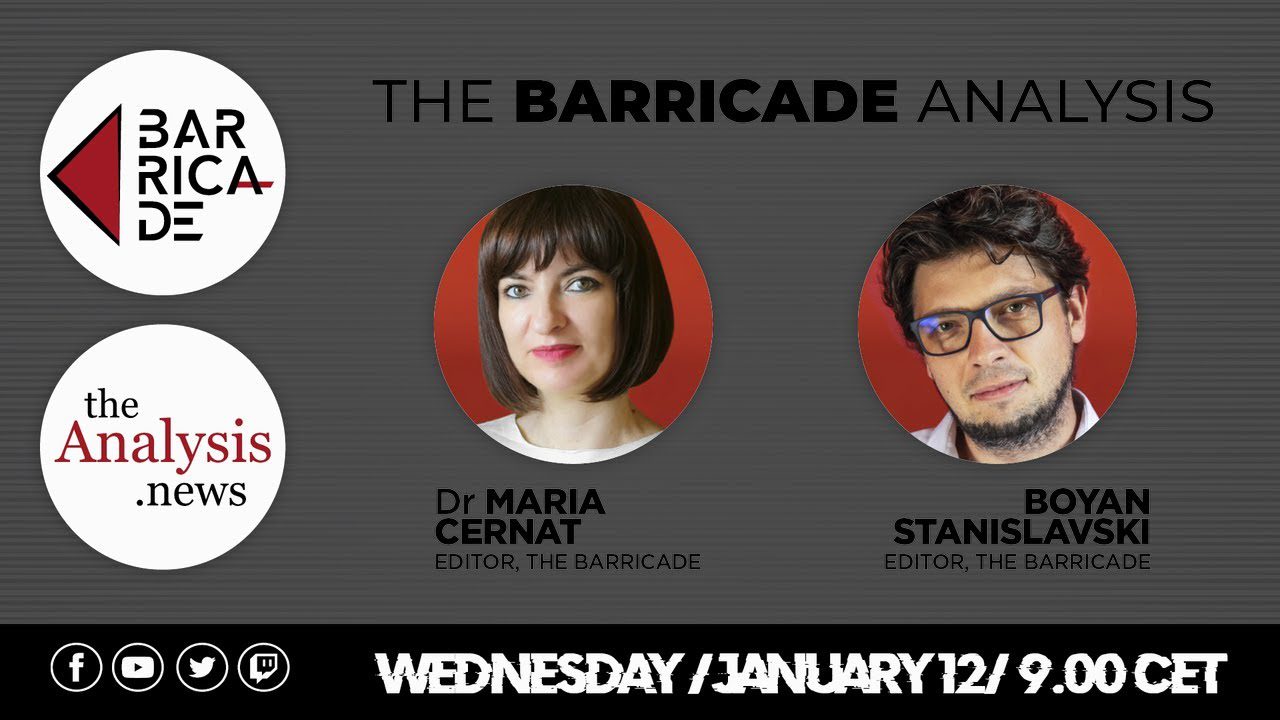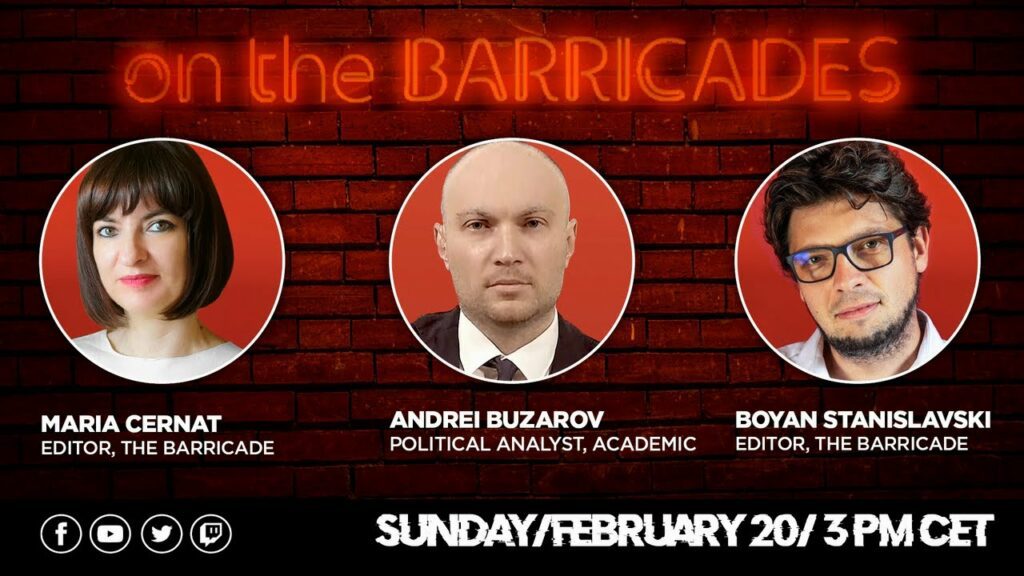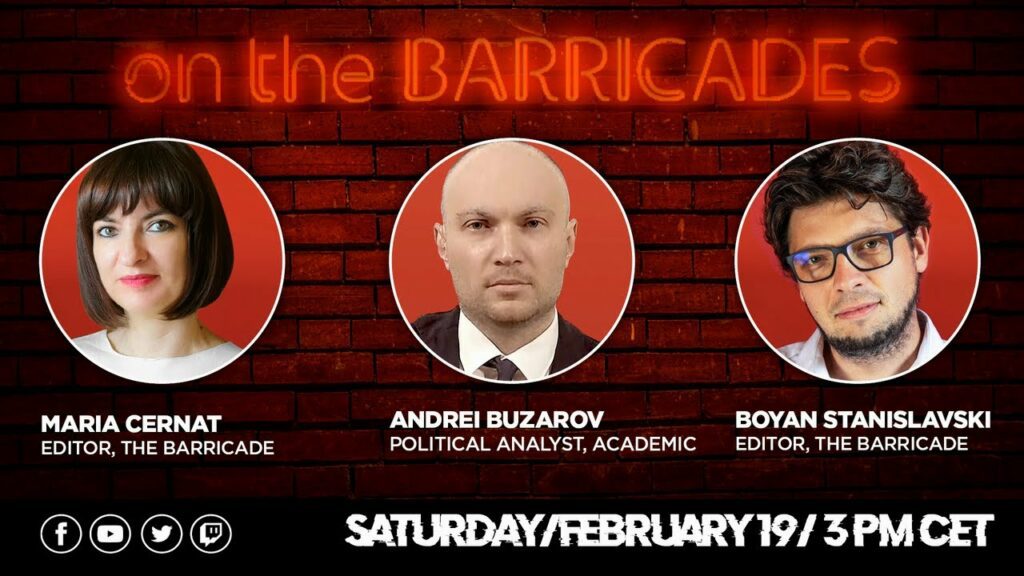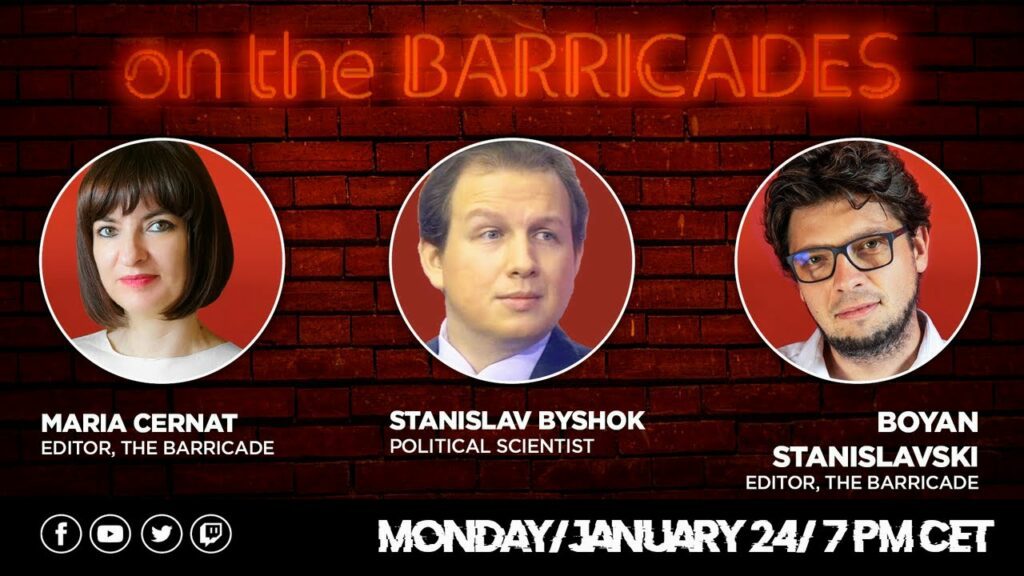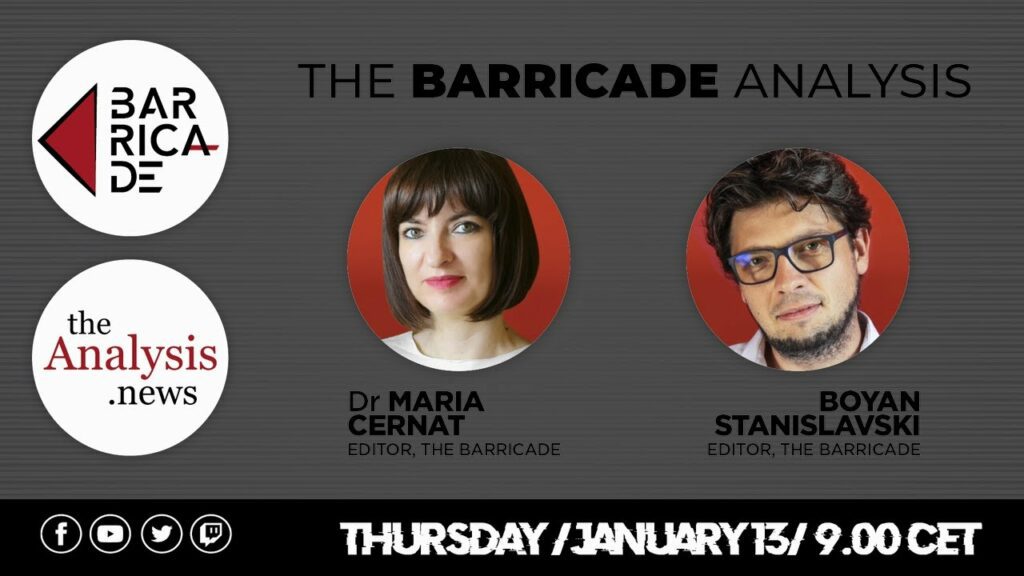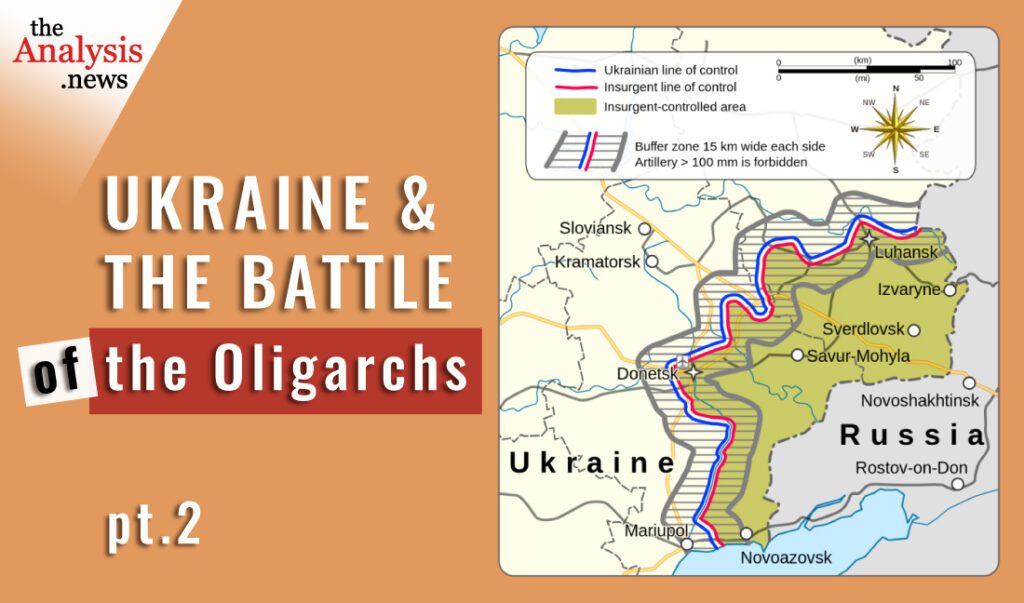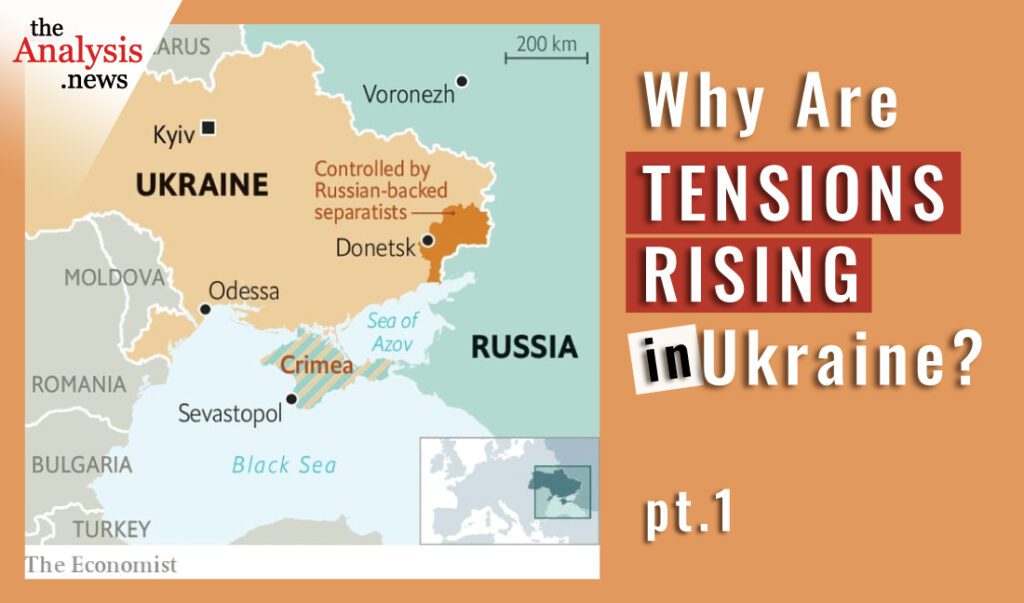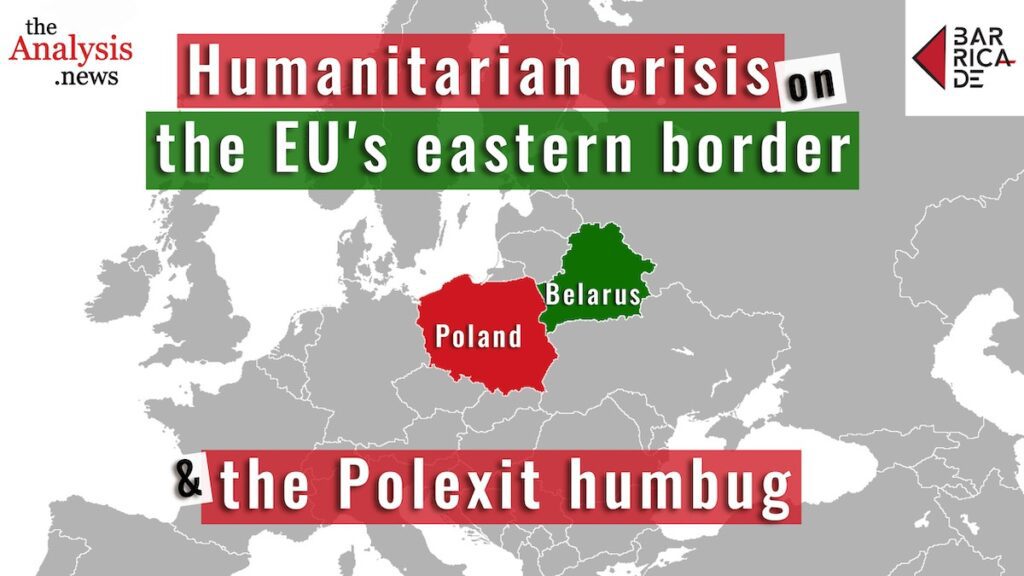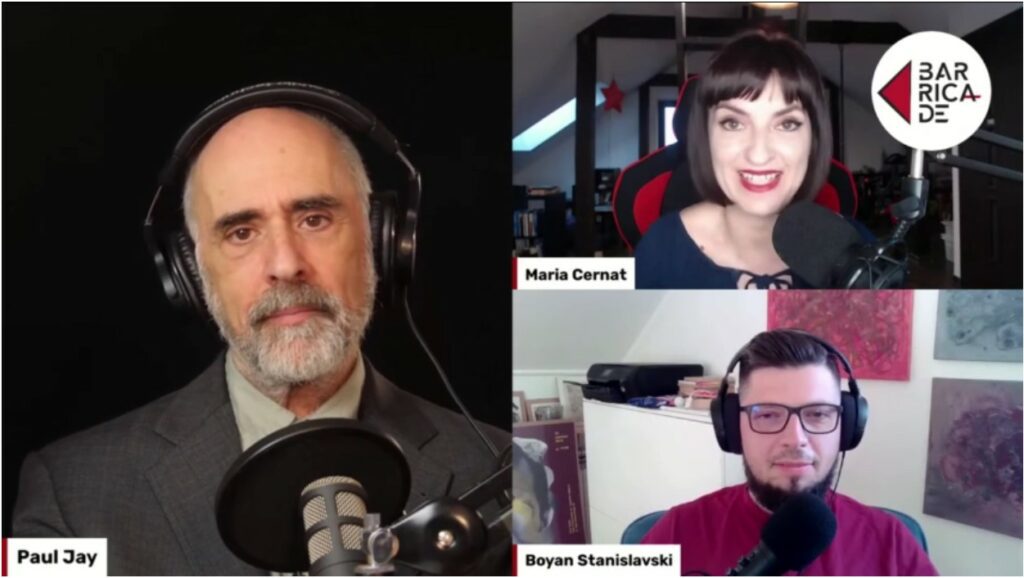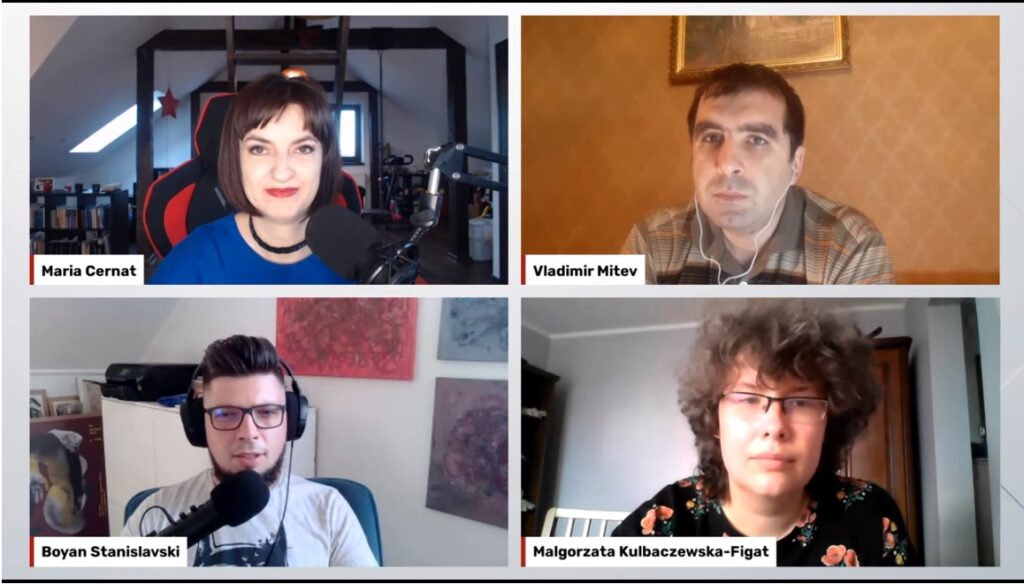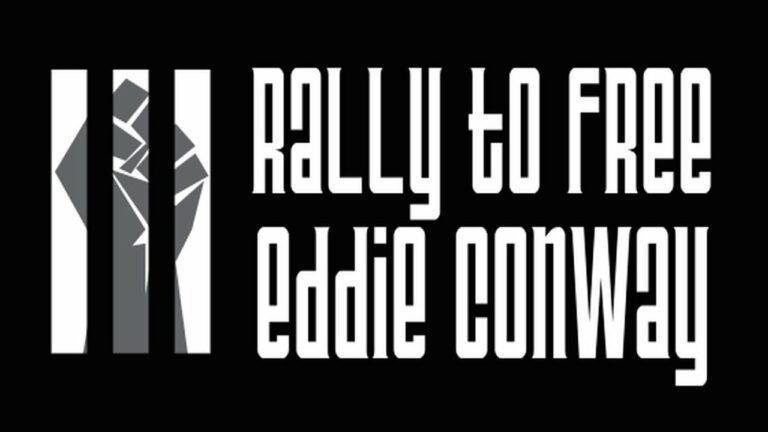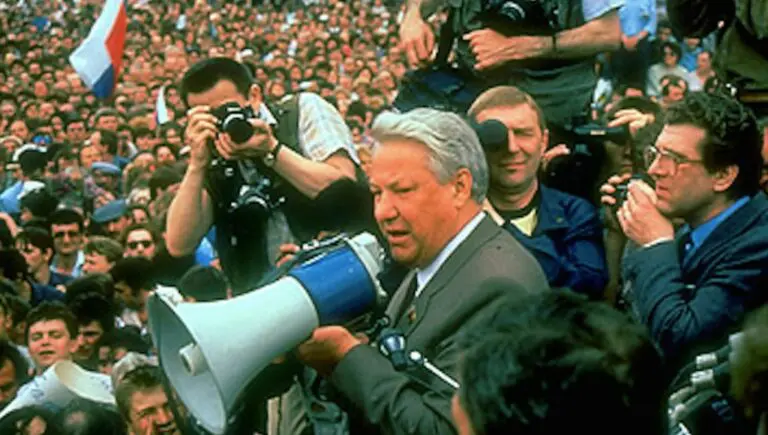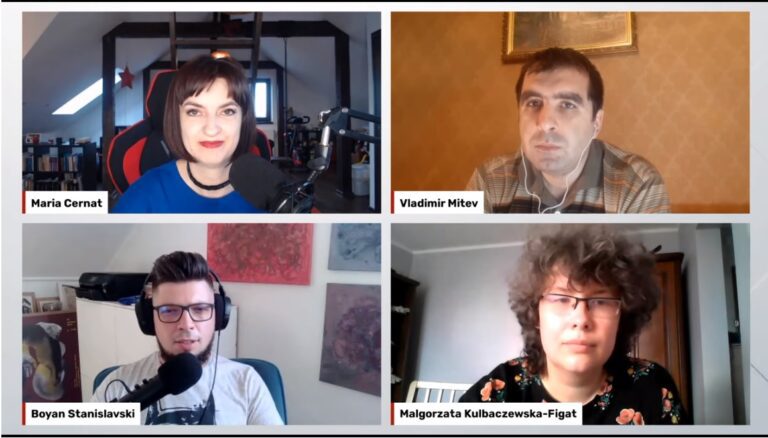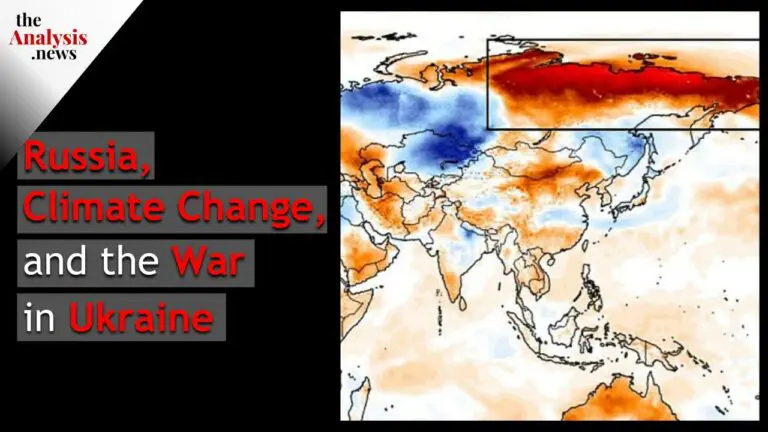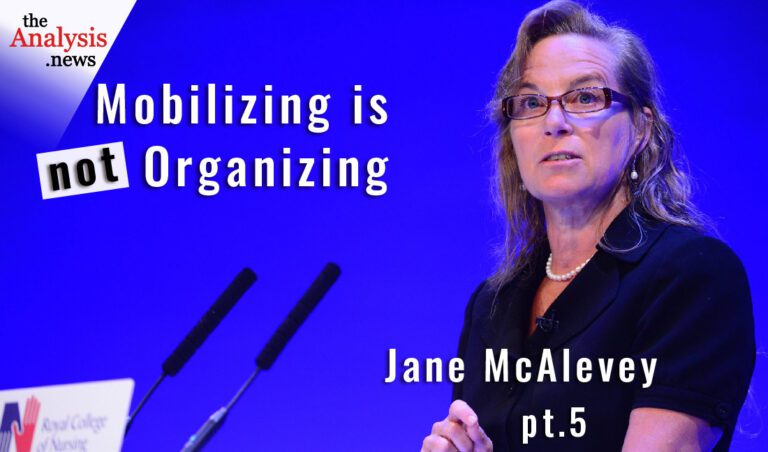Were the events in Kazakhstan a popular workers uprising, a “Colored Revolution”, or a manifestation of power struggles within the Kazakh establishment? Or all of the above? The Barricade’s Boyan Stanislavski and Maria Cernat discuss the general political realities in Kazakhstan today, as well as the fundamental premises for such violent events to have occurred.
TRANSCRIPT
Maria Cernat
Hello and welcome to On the Barricades. This is a special edition that we produce along with theAnalysis.news. This is your host, Maria Cernat, and with me, as usual, the Bulgarian-born Polish journalist Boyan Stanislavski. Thank you for being here with us.
Boyan Stanislavski
Hello, great to be here.
Maria Cernat
We are going to discuss today the situation in Kazakhstan because, at the beginning of last January, the country was dominated by important protests that erupted in several cities. And since January 4th, they have become quite violent. A lot of articles were written, and a lot of speculations were made regarding this protest that in the final aftermath appeared to be a clash between President Kassym[-Jomart] Tokayev and the former leader of Kazakhstan and current head of security, Nursultan Nazarbayev.
The problem in Kazakhstan, and the problem started when the prices for natural liquid gas nearly doubled from €0.1 to €0.2, and that made people very angry. Kazakhstan is a very rich country. It has many natural resources, and the citizens have mainly used this form of gas to move around. They use it for transportation. And of course, sudden doubling of the prices would have meant for a lot of them a huge financial burden. And this is why they started the protests.
On January 4th, all over the country, there were violent clashes between the security forces and the protesters. More than 3,000 people were detained, and 12 people were killed during these clashes.
Because Kazakhstan is a member of the Collective Security Treaty Organization, they asked for help.
Let us discuss a little bit about this Collective Security Treaty that was signed in 1992. And it was signed by Commonwealth, independent States and post-Soviet States. At the beginning, Russia, Armenia, Kazakhstan, Kyrgyzstan, Tajikistan, and Uzbekistan. Those were the countries that initially signed the treaty, and then Azerbaijan, Belarus, and Georgia joined only a year later. China is an observer member in this treaty, and this is important to note. And of course, as I told you, there was a lot of speculation, and I want to warn the viewers that we are not here to take sides. We are here to offer a nuanced and balanced perspective because what happens now in Kazakhstan is very interesting.
In the first part of our show, me and Boyan are going to look at the map. We are going to look at the foreign investment in Kazakhstan and also at the structure of the population. And only then will we begin discussing and analyzing some of the most important hypotheses to be made regarding the current crisis in this country.
So first of all, Boyan, before going to the map, tell me just a very brief impression. What do you think of this protest?
Boyan Stanislavski
Right, So this is a very difficult thing to analyze, really. First of all, I want to say that it’s a confession that I have to make. And I think I owe that to our viewers and listeners that I am not an expert in Central Asian issues. And I don’t have great knowledge about how the political processes unfold in all those countries like Kazakhstan, which is the kind of the beating heart of Central Asia.
But of course, there are the other republics like Kyrgyzstan, Tajikistan, Turkmenistan, and of course, Afghanistan, which is not a post-Soviet, unlike those that I just listed out. But Kazakhstan is very interesting, of course, for people like us. And I feel it should be very interesting or it should appear interesting to the Eastern European Left because this is a country that, with its resources, with its history as a part of the Soviet Union, is definitely, to a certain extent, linked politically to our region now.
So that’s one difficulty that, of course, I had to sort of struggle with. And I encountered it immediately. I just don’t know much. So I spent days trying to figure out what is going on? What were the premises? The general situation, and so on. So like the general context. Because obviously, everything that I accumulated as some sort of general knowledge was not enough for me to go in-depth into what happened in Kazakhstan last week.
Now, that was the first thing. But the second thing was that immediately right after the whole thing gained a sort of violent traction, the whole public opinion in the world, the global public opinion, so to say, was divided into two camps. And one was, of course, the Western camp where everybody started. I mean, it wasn’t reported as extensively as the events in Belarus or Ukraine, but the narrative was the same. People against authoritarianism, people against dictatorship, wanting human rights, wanting democracy, wanting everything that’s good, against everything that’s bad that’s been ruling them since the beginning of times. And that was one narrative.
And then there’s the Russian narrative, which is like the usual thing, which is, again, CIA all over the place. It’s like Americans, imperialists, the West, the collective West; they want to take down Kazakhstan. You look at this, and you really have no way if you don’t spend enough time going through this fixed surface of propaganda if you like. Then you’re risking getting lost in the whole thing and finally maybe losing interest and just waving like shrugging your shoulders. Kazakhstan is like thousands of kilometres from—
Maria Cernat
Let’s see where it is, what do you say?
Boyan Stanislavski
Yeah, right, let’s see where it is. So let me show you the map.
So Kazakhstan is, what we’re looking at is Central Asia, and we’re now seeing Kazakhstan. Everything that you can see above is basically Russia, North of Kazakhstan and East of Kazakhstan. You can see Mongolia, which is here. I didn’t mean to do that. Anyway, this is Kazakhstan, and here is China, which is also pretty important. That is exactly here. Anyway, I’m not able to activate it.
Maria Cernat
We have Kyrgyzstan.
Yeah, anyway, that’s like exactly. China is in the East and Southeast. And then there is Kyrgystan, Uzbekistan, Turkmenistan, and Tajikistan, as well as Azerbaijan, and Georgia that you can see South and Southwest. They are former Soviet republics. And beneath that, we’ve got Afghanistan, Iran, Pakistan and so on.
So that’s the geographical location. Now you can see I’m zooming out just so that you can get a better sense of it. And it’s kind of important perhaps to indicate at the beginning that Kazakhstan is a huge country in terms of territory and geographical area that it covers. And it also has a very peculiar structure where the Kazakhstani society is not exactly like the European or any other society that we know from Europe or North America or other States with the long Republican tradition, so to say.
It’s a state that is divided into three zones which are inhabitated by so-called Zhuz’s. And Zhuz is an organization. I don’t know a federation. I don’t know what to call it exactly, but it’s a tribal organization. And it’s split into three Zhuz’s. There’s the senior Zhuz, there’s the middle Zhuz, and there’s the junior Zhuz or the smaller Zhuz. And this young, small Zhuz is basically in the countries West, in Kazakhstan’s, West.
It’s also where most of the resources are natural resources. I’m talking, and you mentioned in your introduction that Kazakhstan is a very rich country in terms of natural resources. We’re talking about gas here. We’re talking about oil, and also we’re talking about uranium, which is very important. I mean, Kazakhstan is by, I think, the first exporter of uranium in the world. They mine more uranium than Russia and China. This is the West, basically.
Then the North and Northeast is the area which is, I’m not sure how to refer to it exactly. I’ll just say controlled for the sake of the discussion, controlled and inhabited by the senior Zhuz. And then there’s the Southwest, in the Southern and central part and towards the East, which is the middle Zhuz.
And the Western area closer to the Caspian Sea and inhabited by people that are part of this young or small Zhuz is the area that traditionally, since the fall apart of the Soviet Union, served as the basis for the inception of protests and movements and social mobilizations. That sometimes would also transform themselves into mobilizations in the other parts inhabited by the other Zhuz’s.
So many people and many journalists in Kazakhstan and in Russia, and that’s according to what I read in the press, read in the media, in the Russian media and the Russian language media from Kazakhstan and other Central Asian republics. Many people in Kazakhstan and many people in the neighbouring countries that know about Kazakhstan, they don’t necessarily view this like the other processes of social mobilizations that occurred before as something necessarily very political. I mean, sometimes there was a clear political element to that, sometimes there wasn’t. But many people also view that as a kind of rebellious attitude of those tribes and clans because it’s a complicated structure. So there’s Zhuz, which then splits into tribes, and then tribes split into clans. So it’s a kind of complicated thing and a complicated latter.
But anyway, those people that belong to the young or small Zhuz, kind of have this rebellious attitude towards the other Zhuz’s. And that’s one aspect that I think should be taken into consideration here, or at least should not be left out of the general picture. Because why? It transforms and translates rather into the political design if you like. Into the political architecture of the country, which, officially speaking, is a Republic, and that’s what it formally looks like.
But then, because of that complicated structure that I mentioned and because of certain formalities that are required by any Republic to maintain, it ended up creating a certain peculiar arrangement where you have the upper class that recruits people from certain clans or from certain groups within that structure that I just explained.
And they have to rule over, kind of write over their rule above anything else in order to be able to manage the country politically and all other aspects. And this is linked to the Soviet past and the bureaucracy running the state. It created very specific circumstances where the civil servants and the people around the President and the government can exercise enormous power and are very easily incentivized to corruption because they can just do anything.
This was a construction that has always been very difficult to manage, always. Particularly when the corruption sort of kicked in for good in the ’90s and after the fall of the Soviet Union. The person that was in charge, Nursultan Nazarbayev, who used to be an important member of the Politburo of the Kazakhstani Communist Party, that used to be part of the CPSU before 1989, before 1991. It’s a long story, again, we don’t have the time to go into the details of that, although it’s very interesting. But he was able to assert himself as the person that is going to be able to balance between all those structures and between all those cascading dependencies. And, of course, the fact that he was an able bureaucrat does not mean I defend him. And as you said in the beginning, that we’re not here to take sides.
He was an able bureaucrat, obviously, but that all does not mean the fact that he was an enabled bureaucrat, and he was able to sort of put those things together and maintain them somehow does not mean that the processes, that the contradictory processes were not there. Kazakhstan is full of all kinds of contradictions.
Maria Cernat
Speaking of which, this is the perfect segue to look a little bit at the foreign investment, because I find on Statista.com a very nice map that shows you exactly the situation of foreign investment in this country. And I think it’s very important for us to consume it to look at this map because it is not Russia who is in the first place here in terms of foreign investment. Let us now share the screen and see whether we can look at it.
So you see how interesting this is, that basically, Netherlands, the Dutch Shell is there, isn’t it? And then the United States and then Switzerland, and then China and Russia are sharing only 6% in terms of foreign investment.
So while it is true that this country, Kazakhstan, is a member of that security treaty that they signed in 1992, along with other post-Soviet States that I mentioned at the beginning of our show. In terms of foreign investment, it is important for our viewers to consume the idea that the lion’s share is taken by the Netherlands and the United States. Just look at this statistic and how visually it speaks for itself, showing that they are the dominant players here.
Basically, Chevron and Dutch Shell are dominating the foreign investment in this country. And I think this is important for our viewers to consume this. And basically also why is this image very important? Because it shows that it will not be likely that in this country, you will have major sources of uprising coming from the workers because the major corporations that are dominating the landscape are the ones that are very anti-workers and have a vested interest in keeping the status quo.
The status quo, as Boyan mentioned, was that almost for 30 years, that person —
Boyan Stanislavski
Nursultan Nazarbayev.
Maria Cernat
Nursultan Nazarbayev actually named the Astana capital after his name, Nursultan.
Boyan Stanislavski
He first moved it, by the way, from Almaty. He moved it over to Astana, and then he renamed it after his own name.
Maria Cernat
He rebranded it is like I would be the President of Romania, and I would change the name of the capital to Maria. That would be fantastic just to understand how insane this is. But this is the current situation, and he took a step back, and now he had this idea to leave the country into the very wise hands of his daughter. But, of course, that was not possible. So she chose a different disciple into the person of Kassym Tokayev. And this Kassym Tokayev seems to move a little bit further.
Now, Nazarbayev was not out of the picture completely because he was still running, isn’t it the security console. That’s an influence. But now, during the clashes, and it seems that Tokayev used this opportunity to dismiss all members of the government, and a lot of the members of the government were close to this one: Nazarbayev, the supreme leader.
Boyan Stanislavski
Yeah, that’s true. Well, actually, that’s also an important nuance for people to understand, maybe not. But in some post-Soviet countries, the Security Council, including Russia, by the way, is a very important body that actually manages to a large extent the internal political process in Russia, too.
And by the way, like Putin, for example, in Russia, he started out as the head of the Security Council. And many people who are expected to remain active in politics, but they should not be the face of the political process. They are getting sent there. Like, for example, [Dmitry] Medvedev in Russia, he played a part in the Security Council, leading the work of the Security Council when he stopped becoming and being, because they were sort of shuffling it back and forth. Like Prime Minister or President of the Russian Federation. And the same happened here.
Well, there was obviously a problem with Nursultan Nazarbayevbayev, not just because over the course of time, he started to develop these kind of narcissistic tendencies. Starting to think that, like naming the city after his own name, publicly, sort of displaying the will that his daughter inherits all the powers in Kazakhstan.
And by the way, I want to say that he wasn’t completely out of the question. By the way, again, it’s a whole different story. How come she was sort of sidelined, but it wasn’t out of the question, and it was a question. Particularly because the political process in Kazakhstan and the political strike or maybe the architecture of the political process if you like, does not look the same as it does in Europe or America or something like that.
Same goes for Belarus, by the way. In the political process in Belarus, that does not resemble the one that we know from maybe formally like in Kazakhstan to some extent, but otherwise, the essence of it is completely different. And I don’t want to judge here, like whether it’s good or bad and stuff like that.
Maria Cernat
Yeah, It’s the situation.
Boyan Stanislavski
Obviously, there are some authoritarian tendencies, which I don’t like. That’s true, but I’m not going to now.
Maria Cernat
It’s just the situation.
Boyan Stanislavski
Yeah, that’s the situation that has always been there, that has been there for decades. So there were problems with him, not only with Nazarbayev, not only because of his narcissistic, whatever other tendencies and dictatorial measures that were increasingly stupid and that we’re kind of compromising the country and all the rest of it.
That was really just the window dressing that was ugly. Apart from that, there was this thing that he thought, or according to everything that I read, that’s my conclusion. He seems to have thought, like [Alexander] Lukashenko, that he can be the smart guy and he’s going to play ball with the West, he’s going to play ball with the Russians. He’s going to play ball with everyone.
And that worked for a period of time when Russia was on its knees, like not being able to assert its sovereignty and stuff like that, and when Russia was weak and was afraid to take any action and so on and so forth. But things have changed, okay. And we’ve spoken about that many times in our program. I’m not going to repeat that.
But now, when Russia is under this huge international pressure, then obviously things are different. And Nursultan Nazarbayev became an increasing annoyance for them, not because he wanted to play ball with the West, not so much because of that, but he was not a reliable partner for any kind of discussion. Like he was not able to deliver to the Russians whatever they would agree. They would never be able to be sure whether that’s going to be delivered. That’s going to happen and so on and so forth.
So, of course, the situation for them was dangerous because Kazakhstan is not like any other small country that you can just write off whatever sphere of influence that you have as a superpower. It’s a very serious place with a lot of resources and also a 7,000 km long land border with Russia. I believe it’s probably the longest border that Russia has, an inland border that Russia has with any other country. So it’s a matter of national security, obviously, for Russia in these circumstances that we observe now.
Maria Cernat
Can you look, please, at the structure of the population to see how many people live there and what is the structure by religion and ethnic groups? Because this is also important to see. So this is the situation in Kazakhstan, population 90 million roughly, and the Muslim population is 70%, Christian, 20%. And if you look a little bit down, you’ll see that there are two major groups here, of course, the Kazakh population 63%, and also Russians, 23%. Four million people are Russians living in Kazakhstan still.
So this is also very important. Of course, we have it by age group, but this is not so important. It is important to see the ethnic and religious composition of the population. Yes, I would say so. And it’s very important to know that also Russia has there, isn’t it an important base, where they launched Sputnik from.
Boyan Stanislavski
Exactly, that’s exactly what I was going to say.
Maria Cernat
So it’s very important for the Russians to keep things quiet and keep the status quo and not have this.
Boyan Stanislavski
Yeah, I think it’s extremely important what you just said. That’s why, let me just weigh in very briefly on that because the Cosmodrome now has the status of a sort of rented territory that’s rented by Russia. It’s paid for and so on, so forth. It’s not, as some people claim, out of any jurisdiction of the Kazakhstani authorities or anything like that. But anyway, it’s a very important strategic thing.
And this is an inheritance from the Soviet times because, during the Soviet times, many engineers, many scientists and stuff like that were sent to Kazakhstan to develop the astronautic technologies and so on and so forth, which, by the way, Kazakhstan benefited greatly in a sense that this was basically the first influx of modern technology and modern science into that territory of that country. And it remains there. The Cosmodrome remains there.
And also the fact that the country is huge territorially, but it’s not densely populated. We’re talking about 20 million people, more or less, right. So we’re talking about more or less like Romania, right. I mean, this is the population of Romania. This is three-four times the population of Bulgaria. I don’t know, half of the population of Poland, but like territorially, this is nothing comparable by any stretch.
I mean, Kazakhstan is vast, is huge. And that also gives science certain opportunities. We’re talking here about nuclear weapons testing. We’re talking here about all kinds of military technology being tested out there and also huge spaces for drills, which is also very important.
Maria Cernat
Unfortunately, because this is where we live today, and you cannot expect people to go with a peaceful solution. So this is so interesting.
Boyan Stanislavski
Not now.
Maria Cernat
They will use this. Not now, unfortunately.
Boyan Stanislavski
You’re totally right. But then I want to go back to Nursultan Nazarbayev and his figure and why has he been increasingly irritating for the Russians. And not only for the Russians but for anyone pretty much who wanted to maintain some stability because the older he was getting, the more amortized, so to say, his regime was becoming more of a theatre he had to be coming up. Like, we know that from Eastern Europe perfectly. When there are no solutions, the theatre starts to play itself out. And it was pretty much the same thing there.
Now, the thing that was very often used and that is a very useful tool for post-Soviet leaders were nationalistic tendencies that they were able to exploit, and that actually has been, I should say because they still do that in many places; to exploit in order to define themselves as a separate country, separate state, separate entity, separate nation, separate everything. And it was a relatively fairly difficult task because after 50 years or 70 years of being in the Soviet Union.
Maria Cernat
This is so ridiculous, Boyan, because if you look at the map and you see the size of foreign investment, what kind of sovereignty are you talking about? Just look at that. I mean, you have the Netherlands and the United States putting the thumbs on your neck, and you are under their thump economically. What [inaudible 00:29:54] . Of course, this is PR.
There is a famous Russian that says something like ‘when patriotism is debated in an extensive manner, somebody stole something, or economically something is not right’. You know, and I think this is the perfect opportunity.
Boyan Stanislavski
The person you’re referring to, if I’m not mistaken, is Peter Kropotkin, who is, by the way, the only anarchist theoretician that I’m aware of. Like all other prominent figures of international anarchism have never elevated themselves to the level of actually creating some sort of political theory. So Peter Kropotkin had many great phrases, by the way, and that’s true. I think that’s true.
In this case, in the case of the fall apart of the Soviet Union and the sort of assertion of those States and entities and the ruling classes of those States as a political and meaningful factor in internal international politics. They often resorted to that because this was the easiest thing. Everybody was bashing communism, and communism finally ended. Everybody was finally free, allegedly.
So now we should just sort of try to manifest ourselves. And the easiest way to do that is to create some kind of mythology. I’m sure you know much more than I do about these sort of things because you’re a researcher, and I know that you’ve been into this business — well, not into the business of doing that, but into the business of researching this.
So Nursultan Nazarbayev was doing exactly that. And many people were doing that. Lukashenko was doing that. [Leonid] Kuchma was doing that, like the first President of Ukraine, independent Ukraine, and so on so forth. The first thing he did was publish a book, Ukrainians Are Not Russians or something along the lines of it. I can’t remember exactly the title, but something like this.
If such a book was produced in Kazakhstan, that it would actually make a lot more sense in a way that Kazakhstani people are obviously by the way they look and by their ethnicity and by their aesthetics, by their civilizational code, if you like, are totally different from the Russian. Well, or in many aspects, let’s say not totally, but in many aspects different from the Russians, whereas Ukrainians or Belarusians, how can you really tell the difference?
Maria Cernat
Yes.
Boyan Stanislavski
Right.
Maria Cernat
Also, those people in Moldova, I remember that Moldovan’s are not Romanians. We speak the Moldovan language. Ninety-nine percent is the same.
Boyan Stanislavski
Yeah, it’s like Croatian and Serbian, and stuff like this is complete nonsense. But since we spoke of the ethnic-national composition, this is one of the basic contradictions that I mentioned at the beginning of the program. It’s not just that one-fifth or one-fourth of the population is Russian. We’re talking about many Kazakhstani people that are Russian speaking or even Russian identifying, to some extent, for whom the Russian language is the first language that comes before the Kazakhstani language, okay. And this is very important. This is something that you just cannot ignore.
And Nursultan Nazarbayev was actually trying to play with this card, which always ends up badly. And for example, some time ago, he was even attempting to remove the Cyrillic alphabet from the Kazakh and to replace it with Latin. Now it’s like they’re supposed to have equal status.
Like in Serbia, for example. In Serbia, you have equal status. Like the official alphabet is the Cyrillics, but it’s okay to use the Latin transcription as well. And same is pretty much like with all the simplifications of the explanation I’m providing right now. But let’s say it’s a similar situation right now with the Kazakhstani Kazakh language. And let us also, because many people in the West would tell you, oh, this is a sign of Russian cultural imperialism. They want to enforce Cyrillics on everyone. Well, guys, guess what? The Kazakh language before that had no script. So it’s not any imperialism. It’s just like the natural development of how things go, right?
So anyway, that’s just a note on the side, but Nursultan Nazarbayev was doing, even that. You know, it’s a thing which is very offensive or insulting to Russians to do this, it’s like removing, for example, the Red Army monuments in Eastern Europe. Something that has really enraged Russians because it’s like for them, I do know the Russian reality to some extent. For them, it’s like spitting in their face. It’s like spitting on the most sacred thing of their historical identity and historical memory.
So Nursultan Nazarbayev, despite the fact that until now, even throughout this dispute, he was referred to as a pro-Russian or Russian-controlled leader, which is complete nonsense. And at the same time now I have no evidence for this, but I came across that kind of comments in many places that he was also grooming groups of Kazakhstani nationalists and stuff like that he would eventually use in some kind of confrontations that would occur along the lines of what I explained in the beginning between the Zhuz’s or between the tribes or between whatever other, as I said, cascading dependencies that occur in this country.
And because he was getting that irritating, because he was getting that annoying and because he was playing ball with the West, to the extent that Russians felt at a certain point he’s going way too far. And also, China was asserting itself as a superpower over the last couple of years and was trying to sort of secure itself from abroad because of the tensions that are growing over Taiwan and before that as well.
So Kazakhstan became pretty much a focal point. And obviously, there were some incentives produced by Moscow and Beijing and also within the Kazakhstani lead within this bureaucratic case, so to say, that Nursultan Nazarbayev is creating more trouble than stability and that he had to be removed. But this is why he ended up in the Security Council. Because of that complicated architecture and structure in Kazakhstan, it was very difficult to get rid of once and for good. I mean, there are too many factors supporting him and depending on him, and depending on him being in power in order to just stage a coup that would not lead to some kind of horror that would become uncontrollable.
So that’s what they did through all kinds of maneuvering. And again, that’s a very long story. I spent like three days reading through this and sort of getting it. And it’s a complicated story of how through maneuvering, bureaucratic maneuvering, with support from abroad, he was able to be pushed away in 2019 accompanied by mass protest, by the way.
Which again, mass protest, a lot could be said about them. We don’t have the time for it. But there were mass protests, and this was served as a pretext or as a context rather than a pretext to detach him from being a President, which is the most important function that you can have in Kazakhstan.
Maria Cernat
Put him as the head of the security council.
Boyan Stanislavski
Exactly, but not to get rid of him totally, but to sort of make some space. And then that’s when Tokayev stepped in, and then he’s got a very interesting biography the guy Tokayev and again, I’m not taking—.
Maria Cernat
We are going to discuss it in the second segment of our show.
Boyan Stanislavski
Right, okay, we’re running out of time.
Maria Cernat
Yes, we’re running out of time, and we wanted to present some basic details regarding Kazakhstan. Some basic details regarding the very complicated recent history in this country. And we look where this country is, and foreign investment, the structure of population and Boyan gave us a very informed and nuanced perspective on the power structure that is way more complicated than the mainstream media narratives coming from the West or the East may have us believe.
So, in the hope that you enjoy this presentation, we have here the first segment of our show, and we will discuss in the second segment the reactions and the international media and how this very complex situation happening in Kazakhstan was presented in a very simplistic and unproblematic way for the viewers and the readers. And we are going to go into that, of course, analyzing further the nuances of this very complicated power structure in Kazakhstan. Thank you so much, Boyan, for joining and for this information.
And to the viewers, please support us, go to our Patreon page. Patreon.com/TheBarricade thank you, Paul Jay and theAnalysis.news for the opportunity to address your readers and viewers. And with the hope that this was useful and interesting, we end the first segment here. See you in our next segment. All the best.
Boyan Stanislavski
All the very best.
END
